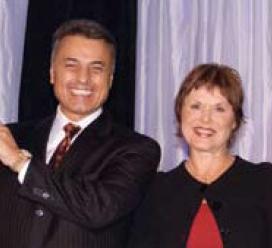MYTH: Saturation Amway
- This concept would be hypothetically possible if the market was static (i.e. one, where new people aren't born).
- In reality, each market is dynamic and new people are born each year.
- Therefore, the people who are sponsored today are mostly those who couldn't have been sponsored in the beginnings of the business.
- Similarly, people who will join the business decades later will talk to and sponsor completely different group of people than most of the recent distributors sponsor right now.
- Saturation, which happened to be one of the key points in F.T.C.
- vs. Amway, has not been shown to be the case with companies such as Amway.[1]
Example
In 2000, according to the 2000 Census Indiana had 2,336,306 households.
- In theory, each of these could form an independent business.
- To take into account required retail sales (50 pv a month) to qualify for bonuses on downline volume, this could yield 1,168,153 Independent Business Owners.
- According to the 6-4-2 plan approved in 1999, this would yield 14,786 Platinum qualifiers, each of which would add between $50-60K to their family income (ncluding the $20,000 Q12 bonus).
- At this point, no new growth is possible in Indiana; 100% of households are either IBOs or customers.
- Those who have not reached Platinum level never will, until household fission and population growth yields new households.
- Now, numbers have been suggested by long-time distributors that only 30% of the population is at any given time willing to consider a business such as this,
- which shrinks the pool of households available to this calculation to a much smaller number;
- however, it has also been observed that many people who decline the opportunity once will often reconsider in the future.
Reality-based Observations
- In actuality, over the course of 50 years market saturation has not been a problem for Amway Global.
- Its products have achieved little name recognition among most consumers in the US, although the Amway name itself may be wider-known. There are several reasons why market saturation has not been reached:
- Inactivity of many Independent Business Owners.
- The definition of an "active" IBO according to the Corporation is one that bought an item, attempted to sell an item or showed the compensation plan once in the past year.
- Many people who start their own business have to "incubate" over time, some for a number of years. However, "incubators" also are not likely to renew.
- One study cited by Joe Pici indicated that $82 a month income was all it took to keep the dream alive long enough for a typical incubator to become engaged. However, for a new business owner it often takes being engaged to earn that money.
- If a distributor is contributing a few PV each month to his upline's organization but not himself growing, then his upline is not seeing geometric growth and neither is he.
- Repeat IBOs. Many who become successful and productive have tried Amway before but dropped out for one reason or another.
- Some cite lack of effective leadership in their line of sponsorship, some cite problems with family or friends, some simply say that they weren't ready to change what they needed to change to get the results they wanted.
- For example, Bobby Britt, brother of Bill Britt of BWW, has talked about how it took being sponsored by Bill three times for him to figure out the Amway system-- and also to convince him to change his habits to see the rewards of his work.
- However, that means that now- productive IBOs could be considered part of the earlier growth of another's organization.
- This "recycling" of distributors actually makes the system more efficient by concentrating growth in the hands of those more experienced though otherwise considered "new."
- However, it also works against the ideal of geometric growth.
- Those most likely to succeed are those who failed before as they have struggled already with what is necessary to develop a successful business.
- International versus Domestic Growth. Much of the growth of Amway Global in recent years has taken place outside of the United States.
- Operating in over 90 countries and territories, a given distributor is not bound by geography to a given market. Most large organizations seem to have portions in other countries.
- Therefore, the potential of the above example in Indiana as a closed system is simply false.
Immigration.
- Amway is not in all countries; it requires a solid domestic infrastructure and relatively stable markets and governments to operate.
- For example, although China and India are two of the most significant markets for Amway Global, the fastest population growth is currently happening in African nations where Amway Global does not operate.
- However, those that emigrate to other nations can become Amway distributors in that market.
- Thus, even refugee crises can in theory aid the growth of Amway Global, constantly bringing new distributors into the network and enabling them to build a better future for themselves and their families.
- Organic Population Growth. World population has not decreased in the past 200 years and there is no reason to expect that it will decrease any time soon.
- There will always be more households through birth and fissioning of existing households, which increases the potential market for growth according to the 6-4-2 plan.
References
- F.T.C. vs. Amway - Saturation



0 comments: